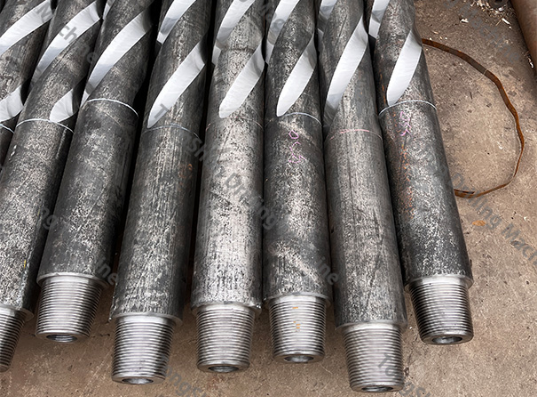Classification and Types of Drilling Pipe
There is a diverse range of drilling pipe types and classifications, each differing in construction, properties, and applications. For offshore drilling operations, selecting the most suitable type of drilling pipe is crucial. It requires a thorough understanding of the various types and classifications, along with their properties.
In this discussion, we will explore the different types of drilling pipes and their respective uses. Additionally, we will underscore key factors to consider when choosing a drilling pipe for your project.
What is a drill pipe?
A drill pipe is a lengthy, hollow steel pipe utilized to rotate the drill bit and circulate drilling fluid within a well. Additionally, it serves as a conduit for deploying other downhole tools. Manufactured to withstand significant external and internal pressure, torsional stress, and bending stress, drill pipes are crucial components in drilling operations.
Drill pipes play a pivotal, albeit sometimes underestimated, role in the drilling industry. These hardened, hollow steel pipes are engineered to endure accidents and withstand the immense pressures encountered in subterranean conditions while facilitating the pumping of drill fluid to the drill bit.
Due to the demanding operating conditions, drill pipes undergo meticulous inspections for signs of wear and tear. To this end, they are evaluated using spherometers, precision instruments capable of accurately measuring the radius of a sphere.
What is a drill pipe used for?
A drill pipe serves multiple purposes in drilling operations. It is primarily utilized to rotate the drill bit and facilitate the circulation of drilling fluid within the well. Additionally, it serves as a conduit for deploying various other downhole tools.
Typically measuring between 30 to 32 feet (9.1 to 9.8 m) in length, drill pipes feature an outside diameter (OD) of approximately 4.5 inches (114 mm). The thickest portion of the drill pipe wall is located at the pin end, where it connects with the drill collar, gradually thinning towards the box end.
At the pin end, the drill pipe is connected to the drill collar, while at the box end, it is connected to the drill bit.
Classification of Drill Pipes
Following assessment with a spherometer, drill pipes are categorized into one of three classes:
1. N-Class Pipe (New Pipe):
This category encompasses the strongest and newest pipes available, typically in pristine or nearly pristine condition.
2. P-Class Pipe (Premium Pipe):
Premium pipes are a step down from N-Class pipes and have experienced some wear but still maintain robust functionality.
3. C-Class Pipe:
C-Class pipes are further divided into three classes: C-1, C-2, and C-3. These pipes vary in wear and may be considered well-worn or nearing the end of their service lives, depending on their rating.
Once a pipe reaches the end of its useful service life, it is graded for scrap, typically marked with red bands. Due to the high cost of drill pipes, they are often reused. Many companies sell both new and used pipes, graded according to the criteria mentioned above, until they are no longer viable for use.
Types of Drilling Pipes
Now that we've covered the fundamentals of drill pipes, let's delve into the various types available.
1. Drill String:
The drill string encompasses the entire column of tools, including the drill pipe, shaft collar, tools, and the drill bit itself. Typically, drill pipe used in the drill string is crafted from tempered steel. For cost and transportation efficiency, sections of drill pipe are usually limited to lengths ranging from 30 to 33 feet.
Given the significant depths involved in drilling, especially offshore, where depths can approach nearly 15,000 feet, different sections are often connected using tool joints. Each section of pipe is equipped with either a male or female connection, enabling secure attachment.
It's important to note that drill pipes come in various thicknesses, each specified for particular applications. Examples include 2 ⅜ inch thick drill pipe, 5 inch thick drill pipe, and 6 ⅝ inch drill pipe.
Drill pipes utilized in the upper sections of the drill string differ in both thickness and construction from heavyweight drill pipe (HWDP), which serves to bridge the gap between drill collars and standard, thinner drill pipe. HWDP will be further discussed below.
2. Heavyweight Drill Pipe (HWDP)
Heavyweight Drill Pipes are, as mentioned before, much stronger than regular drill pipes, because they are designed to deal with the added pressures and stresses arising from serving as transitions between drill collars and regular, thinner drill pipe.
Typically, HWDP is favored for transitions due to its enhanced flexibility compared to solid connections.
It's worth noting that such pipes are thicker, ranging in diameter from 3.5 inches to 6 ⅝ inches, and weigh almost twice as much per foot as regular drill pipe. They are often rated with tensile strengths ranging from 200,000 lbs to over 1,000,000 lbs.
Interestingly, drill pipes usually feature a center upset, or thick wear pads, which prevent the outer surface of the drill pipe from grinding against the rough bedrock of the hole walls. Center upsets are particularly advantageous additions to heavyweight drill pipes, as they reduce wear, tear, and friction, thereby prolonging the lifespan of the drill pipes.
It's important to keep in mind that drill pipes, available in various sizes, diameters, and materials, are broadly categorized into two types: regular drill pipe and heavyweight drill pipe (HWDP), which are used as transitions. Generally, most types of pipes can be purchased new or used and are graded according to three main categories: New (N), Premium (P), and C, with three subdivisions.

评论
发表评论